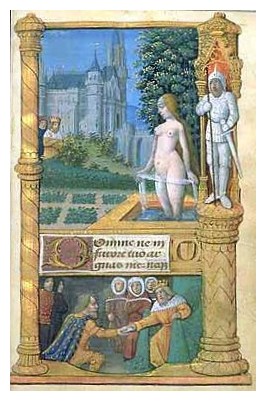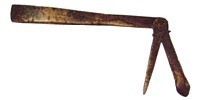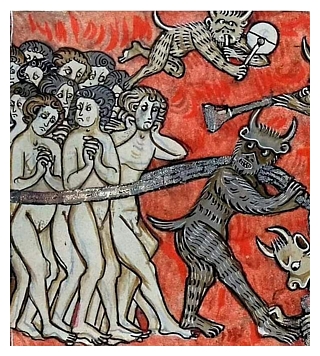|

beauty,
health &
hygiene
general
healthcare
skincare
cosmetics
body
hair
cleanliness,
bathing &
perfumes
hair
care
hair
styles
oral
care
& dentistry
intimate
feminine
hygiene
|

Medieval
Women's Body Hair
 Body
hair of any kind on women is a state which appears to have been
shunned during the medieval period. This is widely reflected in
artwork of the time. Body
hair of any kind on women is a state which appears to have been
shunned during the medieval period. This is widely reflected in
artwork of the time.
Pictured at right is a detail
from the illuminated Book Of Hours For Bourges Use dated
1500 and made in France. Although the time period is towards the
end of the medieval and start of the renaissance periods, the
woman still upholds the traits deemed desirable and beautiful-
pale, white skin, small upright breasts, generous hips, high forehead
and blonde hair.
Even though plucking the
eyebrows and hairline at the top of the forehead was commonplace
for many women, the church was extremely unhappy about this. In
Confessionale, clergymen are encouraged to ask those who
came to confession:
If she has plucked
hair from her neck, or brows or beard for lavisciousness or
to please men... This is a mortal sin unless she does so to
remedy severe disfigurement or so as not to be looked down
on by her husband.
 Many
books cite small tweezers made from copper alloy or silver as
part of medieval toiletry sets. The tweezers at left are dated
from the 15th century and feature brass tweezers, an earscoop
and a nail pick, all hinged to fold away when not in use. Many
books cite small tweezers made from copper alloy or silver as
part of medieval toiletry sets. The tweezers at left are dated
from the 15th century and feature brass tweezers, an earscoop
and a nail pick, all hinged to fold away when not in use.
 Contemporary
artworks, when they show the female private parts at all, show
it clear from any growth of hair. Since the general practice of
tweezing the face and hairline to achieve a fashionable look was
popular, it is not hard to imagine that women may have also removed
the unwanted hair from the pubic region. The image at right, shows
a rare image where the female genitals are shown completely uncovered,
giving us a view of her private parts, which are hairless. Contemporary
artworks, when they show the female private parts at all, show
it clear from any growth of hair. Since the general practice of
tweezing the face and hairline to achieve a fashionable look was
popular, it is not hard to imagine that women may have also removed
the unwanted hair from the pubic region. The image at right, shows
a rare image where the female genitals are shown completely uncovered,
giving us a view of her private parts, which are hairless.
Trotula de Ruggiero's 11th
century treatice, De Ornatu Mulierum (About Women’s
Cosmetics) advises a hair removal remedy for women:
In order permanently
to remove hair. Take ants' eggs, red orpiment, and gum of
ivy, mix with vinegar, and rub the areas.
A written reference to female
pubic hair is in the telling of the tale of Griselda, a
popular story many times retold, of a cruel husband and his submissive
and enduring wife. In one version, the husband Gualtieri discusses
the type of woman who when turned out of her house in only a chemise
would warm her wool or rub her pelt against another
man to procure fine clothing. It is fairly certain the the wool
and pelt referred to is the woman's pubic hair. From this we can
ascertain that at least some women retained their hair.
Chaucer, too, in the Miller's Tale talks a woman who is bearded
around hir hole.
To counter this view, Erasmus
in his work The Praise of Folly speaks of an old woman
buying herself a younger lover saying:
Nowadays any old dotard
with one foot in the grave can marry a juicy young girl, even
if she has no dowry.. But best of all is to see the old women,
almost dead and looking like skeletons who have crapt out
of their graves, still mumbling "Life is sweet!"
As old as they are, they are still in heat still seducing
some young Phaon they have hired for large sums of money.
Every day they plaster themselves with makeup and tweeze their
pubic hairs; they expose their sagging breasts and try to
arouse desire with their thin voices.
Even though this text was
written in 1509, it shows that at that point, it was normal for
a woman to be without pubic hair. Whether this extended to the
peasantry is doubtful and whether it extended to all of the European
countries can only be guessed at.

Copyright
© Rosalie Gilbert
All text & photographs within this site are the property of
Rosalie Gilbert unless stated.
Art & artifact images remain the property of the owner.
Images and text may not be copied and used without permission.
|